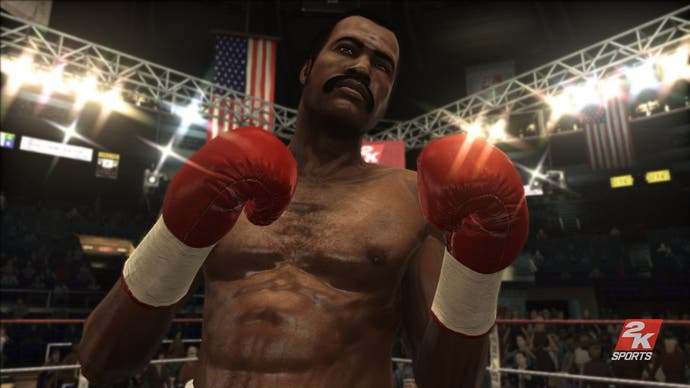Don King Presents: Prizefighter
Don and dusted.
"Martin Luther King took us to the mountain top," Don King once said. "I want to take us to the bank." 2K Sports is up for that, and so we have Don King Presents: Prizefighter, which pretends to be a sports documentary looking back on the life of a world-conquering boxer called The Kid. You.
We begin by designing The Kid. The Career mode focuses on heavyweights, so options are limited to appearance, whether he's orthodox or southpaw (right- or left-handed) and what sort of trunks he wears. Be careful though, because if your man's tall and his shorts are short, he looks like a bloke in a nappy. No one wants that. Apollo Creed wouldn't stand for that.
Then you watch some videos. This is Prizefighter's gimmick: Don King and other figures from the world of boxing, and a selection of actors, have recorded a range of fake interviews detailing the trials and tribulations The Kid faced on his route from back-room brawler to heavyweight champ. The game's producers (or more likely Don King's production company) have chopped them up into little quick-fire sound-bites and strung them together.
It's like speed-dating a gossip column. The man on the yacht says such and such was inevitable, but Don disagrees. Then an old girlfriend says The Kid was pushed, a man drinking champagne in a limo concurs, a man on a bus says no, man on yacht says yes, mechanic says something else, and Don has the final word. It's quite convincing, but it's hard to keep track of what you're being told, because there's no specific exposition - just recollected bias about whichever situation The Kid was in at the time, delivered in a couple-of-minutes sequence every time you beat the current tier's top contender. Still, it's a bit different.
More familiar is that, as a boxer starting out, you have to warm up by punching nobodies. So, following a quick button tutorial and two rounds of training mini-games, you're in the ring going toe-to-toe with the semi-fictional boxing world's expendables. Unlike Prizefighter's main competition, EA Sports' Fight Night Round 3, attacks are mapped to buttons and triggers. Right and left hooks, the jab and a straight punch get their own face button each, while uppercuts, body blows and sidestep-punches are combinations of trigger or bumper and face. There are loads of combinations to figure out.

As you fight, the camera circles close to the fighters, watching largely from the side so you can react to what the other fighter's throwing, and observe gaps in his defence. Defence is a mixture of ring movement, using the right stick to hold your hands in front of your face or at your sides to block body shots, and standing on the spot weaving your upper body around to keep your head out of trouble.
It all looks alright from this perspective, but isn't anything to shout about. Fighters are a bit angular but sweat convincingly, although they start to resemble rain-drizzled metal after a while under the lights and faces lack life. One of Fight Night Round 3's tricks was a one-two combo of low light and clever shading, and Prizefighter stumbles into the old trap of going bright a bit too starkly on faces.
Meanwhile, arenas and other characters - most notably trainers, who have dialogue spoken through yapping mouths on otherwise-immobile faces - look like PS2 rejects, not even in new clothes. Remember the old days of shirts that were just textured skin? They're back. Combat itself is better: there's enough muscle and skin movement all over the body to capture the sting of a strong punch, and most of the attack animations have a certain heft to them if they connect.

Key to landing those attacks is learning the basic buttons and then paying attention to your stamina - a blue meter that starts off full and empties quickly when you dash, throw punches (whether they connect or not) or take hits. With full stamina you can attack somewhat fluidly, but once you run out of stamina you slow to a crawl, so unless the other guy's on the ropes (literally or figuratively, for once) you need to withdraw or go defensive for a few seconds to recover your speed.
Pressing the attack is important, though, because the health system is in two parts, and one of them recharges. Your current health status is bright orange, and when you run out and receive a punch you will be knocked down, but over time without impact this health will recover. However, the degree to which it can recover diminishes over the course of a fight's many rounds, particularly if you get knocked down a lot. You can tell who's on top at any given time by looking at the orange, but it's the darker full-health bar that tells the story of the fight.


